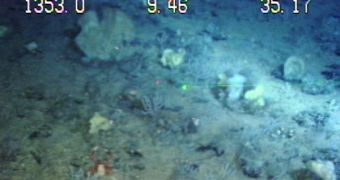Researches spanning 18 years have proved beyond a shadow of a doubt that the marine wildlife occupying the bottom of the Pacific Ocean, several miles beneath the surface, is severely affected by changes in the atmosphere, such as the formation of tropical storms or the El Nino phenomenon. Scientific experiments showed that dwellers such as arthropods and large worms lose their food supply if the weather outside breaks down.
The complicated relations that exist between the inhabitants of ocean floors and the air movements that occur in the upper layers of the atmosphere have finally been exposed by scientists working at UK's National Oceanography Center in Southampton, and others at the Monterey Bay Aquarium Research Institute in California. They have been monitoring deep-water dwellers for almost two decades from an underwater laboratory, located approximately 200 miles (320 kilometers) off the coast of Santa Barbara.
The team studied animals such as sea cucumbers, anemones, crustaceans, arthropods and copepods, all living deep underwater, on or inside the mud that covers the ocean floors. After looking at years of recordings, the scientists realized that changes on the surface, such as the forming of an El Nino phenomenon, drastically reduce the food supply that reaches the depths. Within 12 months of such an event, the species equilibrium breaks down, and arthropods become dominant as a species, even though they are smaller than sea worms.
Scientists also noticed an overall decrease in populations, which seems to point out that less and less food reaches the ocean floors. The upwelling process that is essential to oceans, when bottom waters rise to the surface and feed the plankton above, is also disturbed during atmospheric phenomena. As a result, plankton falls back to the depths and is consumed by bottom-dwellers. Less plankton means less food for other maritime species, considering that it represents the basic link in the oceanic food chain.
These results are important, because they offer scientists trying to tackle global warming a novel way of looking at the interactions that occur in the oceans and in the atmosphere. Those who proposed daring solutions for reducing the effects of global warming, such as injecting tiny iron particles in the waters, so as to help iron-consuming plankton regenerate, must now calculate the impact that this measure will have on the atmosphere as well.

 14 DAY TRIAL //
14 DAY TRIAL //